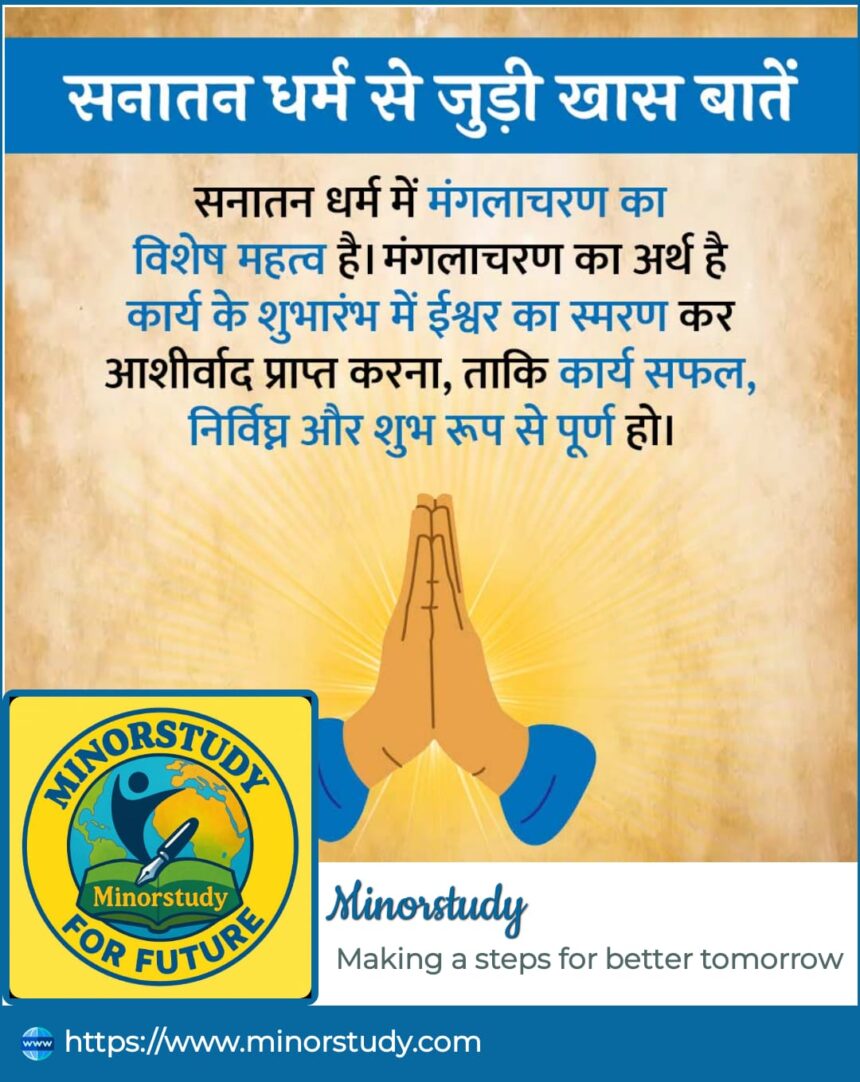🌼 7 Powerful Reasons Why Mangalacharan Is the Soul of Sanatan Dharma – A Timeless Tradition of Positivity
Mangalacharan: Sanatan Dharma, often referred to as the eternal way of life, is not just a religion but a universal system of righteousness, values, discipline, and cosmic harmony. One of its most revered and foundational practices is “Mangalacharan” — the invocation of the Divine at the very beginning of any task.
- 🌺 What Is Mangalacharan?
- 🕉️ A Glimpse Into Its History
- 📌 7 Powerful Reasons Why Mangalacharan Is Essential
- 1. 🧘♂️ Spiritual Alignment
- 2. ⚡ Removes Obstacles
- 3. 🎯 Enhances Concentration
- 4. 💫 Establishes Auspicious Energy
- 5. 🌈 Connects With Eternal Dharma
- 6. 📖 Preserves Vedic Tradition
- 7. ❤️ Instills Calmness and Hope
- 🪔 Common Mangalacharan Mantras and Their Significance
- 📅 Timeline of Mangalacharan Through Time
- 🌻 Daily Life Impact of Mangalacharan
- 🤔 Frequently Asked Questions (FAQs)
- Q1: Is Mangalacharan only for religious practices?
- Q2: Who should recite Mangalacharan?
- Q3: Can I do Mangalacharan silently?
- Q4: What if I forget to do it?
- 🌟 Significance in Society
- 🌼 Best Wishes & Messages
- 🧭 Conclusion: A Humble Start is a Glorious Path
In this spiritually enriched exploration, we dive into the history, significance, observance, facts, FAQs, and real-life impact of this sacred practice. Let’s understand why Mangalacharan holds such unmatched importance in Sanatan Dharma, and how it continues to shape daily life with serenity, success, and sacredness.
🌺 What Is Mangalacharan?
Mangalacharan (मंगलाचरण) is a Sanskrit term meaning auspicious invocation or beginning. It typically refers to a prayer, chant, shloka, or mantra recited at the start of any activity — be it writing, teaching, studying, performing rituals, or beginning any new task.
It involves:
Remembering or bowing to Ishwara (God), Guru, or Divine Powers
Seeking blessings for a smooth journey
Creating a positive mental and spiritual environment
🕉️ A Glimpse Into Its History
📜 Ancient Origins
The practice of Mangalacharan dates back to Vedic times, where rishis would begin any yajna (sacrifice), ritual, or composition by invoking deities like Agni, Saraswati, or Ganesha.
All classical Indian texts — Ramayana, Mahabharata, Puranas, and even Natya Shastra — begin with a Mangalacharan.
Kalidasa, the legendary poet, began his works by invoking divine blessings — such as “Vagarthaviva Sampriktau…” in Raghuvamsha.
🕯️ Evolution Through Eras
| Period | Form of Mangalacharan |
|---|---|
| Vedic Era | Invocations to Agni, Indra, and Varuna |
| Epic Age | Worship of Narayana, Shiva, Saraswati |
| Medieval Era | Emphasis on Guru-Vandana and Ganesha |
| Modern Times | Includes national, social, and universal prayers |
📌 7 Powerful Reasons Why Mangalacharan Is Essential
1. 🧘♂️ Spiritual Alignment
Mangalacharan aligns the body, mind, and soul to a higher power, ensuring clarity, focus, and divine guidance throughout the activity.
2. ⚡ Removes Obstacles
Invoking Lord Ganesha or Ishta Devata eliminates mental, emotional, and external hindrances — paving the way for success and peace.
3. 🎯 Enhances Concentration
Chanting a Mangalacharan shloka or mantra instantly centers the practitioner, sharpening their awareness and making them present in the moment.
4. 💫 Establishes Auspicious Energy
Just like lighting a diya in darkness, it invites positive vibrations and sacredness into the space — be it home, classroom, or temple.
5. 🌈 Connects With Eternal Dharma
It’s a reminder that every act, big or small, is part of a divine cycle. This understanding brings humility, gratitude, and dharmic responsibility.
6. 📖 Preserves Vedic Tradition
It sustains the flow of ancient mantras and Sanskrit wisdom, keeping the oral tradition of Sanatan Dharma alive and vibrant.
7. ❤️ Instills Calmness and Hope
Whether in school assemblies, pujas, or cultural events, it creates emotional stability, sacred silence, and hopeful intention at the outset.
🪔 Common Mangalacharan Mantras and Their Significance
| Mantra | Meaning |
|---|---|
| “Om Gan Ganapataye Namah” | Salutations to Lord Ganesha, the remover of obstacles |
| “Gurur Brahma Gurur Vishnu…” | Honors the Guru as the embodiment of God |
| “Vakratunda Mahakaya…” | Invokes Ganesha for wisdom and clarity |
| “Saraswati Namastubhyam…” | Pays respect to Goddess Saraswati before learning |
| “Shri Ramaya Namah” / “Om Namah Shivaya” | Establishes divine presence in ritual or action |
📅 Timeline of Mangalacharan Through Time
| Era | Practice |
|---|---|
| Pre-Vedic | Nature invocation (sun, rain, fire) |
| Vedic | Agni Sukta, Saraswati Vandana |
| Ramayana-Mahabharata | Nārāyaṇa invocation, Ganesha vandana |
| Bhakti Movement | Saints began with Bhajans or Guru Vandana |
| Present Day | Found in school prayers, script introductions, temple rituals |
🌻 Daily Life Impact of Mangalacharan
In Education:
Students chanting “Saraswati Vandana” before studies perform better and stay disciplined.
In Spiritual Practice:
Daily Shiva or Vishnu dhyana begins with mantras that open the heart and calm the mind.
In Homes:
Beginning with “Shubham Karoti” or “Om Shanti” before meals, discussions, or puja creates harmony and positivity.
In Modern Professions:
Writers, artists, and coders invoke creativity through chants or meditation at the start of their tasks.
🤔 Frequently Asked Questions (FAQs)
Q1: Is Mangalacharan only for religious practices?
No. It is a universal method to bring focus, clarity, and positivity in any beginning — be it spiritual, educational, or professional.
Q2: Who should recite Mangalacharan?
Anyone can. There’s no age, gender, or caste barrier. It’s more about intention and reverence than formality.
Q3: Can I do Mangalacharan silently?
Yes. Silent remembrance of the Divine is also a form of Mangalacharan.
Q4: What if I forget to do it?
There’s no sin — but it’s an opportunity missed to align with sacred energy.
🌟 Significance in Society
Teaches gratitude before action.
Builds a peaceful, value-based culture in homes and institutions.
Connects society to its cultural and moral roots.
Promotes mindful living and spiritual reflection in a busy modern world.
🌼 Best Wishes & Messages
“May every beginning be blessed with divine guidance – Mangalacharan brings victory before the journey begins.”
“Let your thoughts rise with a mantra and your deeds end in peace. Wishing you an auspicious beginning!”
“Start with faith, walk with truth, and succeed with blessings — this is the essence of Mangalacharan.”
🧭 Conclusion: A Humble Start is a Glorious Path
In Sanatan Dharma, how you begin matters as much as how you end. Mangalacharan is not superstition — it is intention in action. It reminds us that every deed is sacred, and that surrendering to the Divine is the highest form of wisdom.
In a world full of haste and chaos, Mangalacharan invites us to pause, reflect, and begin with grace. Whether you are starting your day, your career, or your spiritual path — remember:
“He who bows at the start, rises with strength and finishes with peace.”








